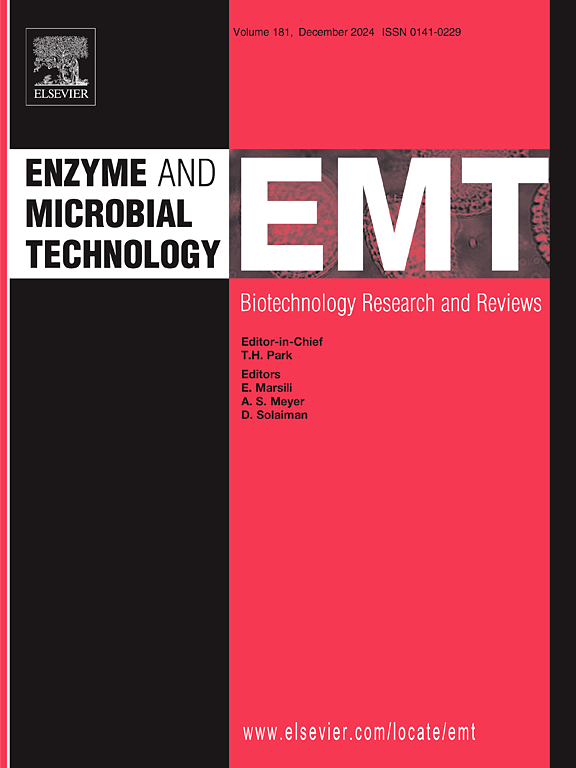Engineering the D-lactic acid responsive promoter/repressor system as dynamic metabolic engineering tool in Lactobacillus delbrueckii subsp. bulgaricus for controlled D-lactic acid biosynthesis
IF 3.7
3区 生物学
Q2 BIOTECHNOLOGY & APPLIED MICROBIOLOGY
引用次数: 0
Abstract
Dynamic metabolic engineering integrates synthetic logic circuits into cellular systems, optimizing metabolic fluxes and augmenting biosynthesis of target metabolites. This study evaluated a D-lactic acid (DLA)-responsive promoter-repressor system from Pseudomonas fluorescens A506, re-engineered for heightened sensitivity and functional efficacy in Lactobacillus delbrueckii subsp. bulgaricus VI104. The codon-optimized regulatory architecture exhibited peak performance at DLA inducer concentration range of 60–100 mM, validated by fluorometry and microscopy. As an application, overexpression of D-lactate dehydrogenase (dldh) downstream of the engineered promoter repressor system enabled finely tuned modulation of DLA biosynthesis, autonomously regulating the transition between growth and production phases, thereby attenuating overall metabolic load. Cross-species compatibility was confirmed by excising regulatory elements from the promoter-repressor system and functionally assessing them in recombinant L. bulgaricus. Molecular docking elucidated critical noncovalent interactions between D-LldR repressor and operator nucleotide sequence in absence of inducer DLA. The engineered promoter construct with high efficiency effectively elevated DLA biosynthesis by 2.15-folds and expanded the overall fermentation time relative to constitutive systems, attaining maximum DLA titre of 9.02 g L⁻1 in bioreactor setup. These results substantially broaden the molecular cloning toolkit available for L. bulgaricus, fostering potential future applications in biotherapeutics and probiotics.
德氏乳杆菌d -乳酸启动子/抑制子系统的动态代谢工程用于控制d -乳酸的生物合成
动态代谢工程将合成逻辑电路集成到细胞系统中,优化代谢通量并增加目标代谢物的生物合成。本研究评估了来自荧光假单胞菌A506的d -乳酸(DLA)响应启动子-抑制子系统,该系统经过重新设计,以提高德布鲁克氏乳杆菌亚种的敏感性和功能功效。发酵剂VI104保加利亚。通过荧光和显微镜验证,密码子优化的调控结构在DLA诱导剂浓度范围为60-100 mM时表现出最高的性能。作为一项应用,工程启动子抑制子系统下游的d -乳酸脱氢酶(dldh)的过表达实现了DLA生物合成的精细调节,自主调节生长和生产阶段之间的过渡,从而减轻了总体代谢负荷。通过在重组保加利亚乳杆菌中剔除启动子-抑制子系统中的调控元件并对其进行功能评估,证实了其跨物种相容性。分子对接阐明了D-LldR阻遏物与操作核苷酸序列在缺乏诱导物DLA的情况下的关键非共价相互作用。与组成体系相比,高效的工程启动子构建有效地将DLA生物合成提高了2.15倍,并延长了总体发酵时间,在生物反应器设置中达到了9.02 g L - 1的最大DLA滴度。这些结果大大拓宽了保加利亚乳杆菌的分子克隆工具,促进了生物治疗和益生菌的潜在未来应用。
本文章由计算机程序翻译,如有差异,请以英文原文为准。
求助全文
约1分钟内获得全文
求助全文
来源期刊

Enzyme and Microbial Technology
生物-生物工程与应用微生物
CiteScore
7.60
自引率
5.90%
发文量
142
审稿时长
38 days
期刊介绍:
Enzyme and Microbial Technology is an international, peer-reviewed journal publishing original research and reviews, of biotechnological significance and novelty, on basic and applied aspects of the science and technology of processes involving the use of enzymes, micro-organisms, animal cells and plant cells.
We especially encourage submissions on:
Biocatalysis and the use of Directed Evolution in Synthetic Biology and Biotechnology
Biotechnological Production of New Bioactive Molecules, Biomaterials, Biopharmaceuticals, and Biofuels
New Imaging Techniques and Biosensors, especially as applicable to Healthcare and Systems Biology
New Biotechnological Approaches in Genomics, Proteomics and Metabolomics
Metabolic Engineering, Biomolecular Engineering and Nanobiotechnology
Manuscripts which report isolation, purification, immobilization or utilization of organisms or enzymes which are already well-described in the literature are not suitable for publication in EMT, unless their primary purpose is to report significant new findings or approaches which are of broad biotechnological importance. Similarly, manuscripts which report optimization studies on well-established processes are inappropriate. EMT does not accept papers dealing with mathematical modeling unless they report significant, new experimental data.
 求助内容:
求助内容: 应助结果提醒方式:
应助结果提醒方式:


